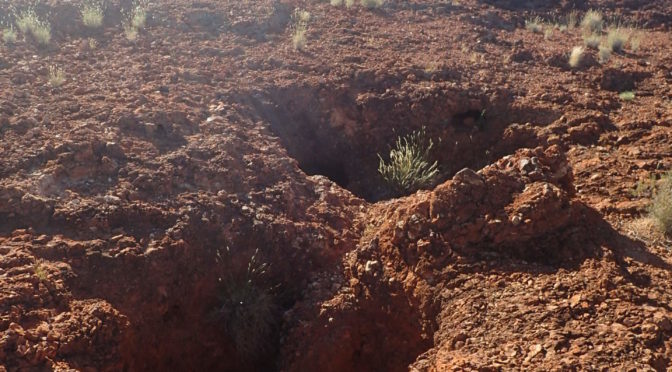Filled water bottles from the gnamma holes behind the White Cross, dosed ’em with tincture of iodine (3 drops/litre, leave at 20C for half an hour to kill most waterborne bugs) then headed to Tjukayirla roadhouse.
Stopped en route at one of the ‘soaks’ that enabled aborigines and early white travellers to traverse the GCR. This showed how hard travel then was, and how much work went in to surviving here. The ‘soak’ is just a claypan below a rocky ridge. No surface water, only a change in vegetation from mulga on red sand to low salt bush on white clay indicating that (salty) water was not far below the surface. To get enough water to survive and make it to the next drinkable water you picked what looked like the lowest point, dug as deep a hole as you could manage and went to bed. If you were lucky, by morning the hole had a puddle of salty water seep in overnight. If you were unlucky, you dug a deeper hole and went to bed again. If really unlucky, you died.
The next gnamma hole was not guaranteed either; most of the gnamma holes are just small (less than a metre across and less than a metre deep) solution holes etched into ironstone rock outcrops, there is not generally a connection to any sort of aquifer although a few do have such a connection). Accordlingly, gnamma holes would dry out within weeks of the last rain. Misjudge your trip and again, you died.
Another stretch of rubbish sandy road and then a 5 km stretch of bitumen at the Tjukayirla_Roadhouse (actually a Royal Flying Doctor emergency airstrip) and a re-supply point. The bore water at the roadhouse is fine to drink, no need to buy water.
The operators of the roadhouse were nice people. The sign saying to lock up your shoes because the dingos would steal them was disconcerting, as was the host’s story about the guy who was bitten by a death adder and ended up bleeding from his eyes by the time the RFDS picked him up four hours later. He was flown to Kalgoorlie base hospital and survived.
Tjukayirla_Roadhouse is close to The Zoo first identifed by Paine and Barclay surveyors in the late 1800’s.
There were also some gnamma holes just metres from the roadhouse campground. I tried to get some young tourists interested in this local history but didn’t get a bite.

Apparently ‘tjukayirla’ in the local language translates to roughly ‘life saving water holes for travellers’

